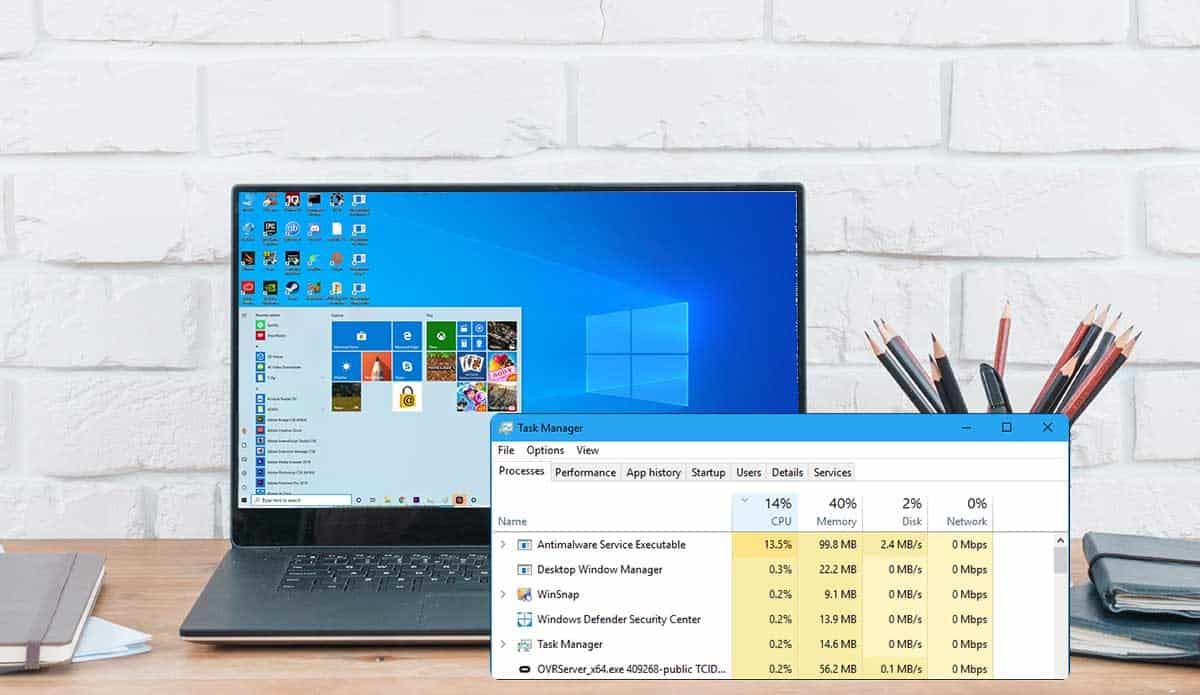Windows 10 runs quite some services in the background. So, These services typically do not take priority when it comes to using system resources. User processes are generally given priority. There will be times when specific Windows processes take precedence, though, and then take up more CPU power. If you see high CPU usage by Antimalware Service Executable (MsMpEng), and it is consistent, you may need to look into it & possibly fix a problem or two.
[lwptoc]
Antimalware Service Executable (MsMpEng)
The Antimalware Service Executable (MsMpEng) is Windows Defender. It will run all the time, so if you see it in Task Manager, it’s nothing to worry about. So, The worrying thing is if it’s consistently using a lot of the CPU’s power. Suppose your system is idle, the CPU usage will go up since Windows Defender uses the downtime to run scans, although you should not see consistently high CPU usage from this process.
FIXED: Antimalware Service Executable High CPU Usage (MsMpEng)
1. Restart the System
Well, Desktop computers don’t need to be shut down every night. So, Most do fine by going into a low-power state. It is fine until processes begin to stall. This is a problem with Windows 10. Try restarting your system & see if this process’s usage returns to normal (single digits/low double digits).
2. Run a Full Scan
This high CPU usage by Antimalware Service Executable may be caused by a long-overdue scan that needs to run. Usually, the simple solution is to allow a full scan to run. You will need to stop the service in its current state and then initiate a fresh scan. This is best not to use your system until the scan completes so that it ends faster.
- Open Windows Defender.
- Move to Virus & Threat Protection.
- Tap Manage Settings under Virus & threat protection settings.
- Then, Turn off all the switches.
- Next, Restart the system.
- So, Once you’re back on your desktop, turn all the Virus & threat protection settings back on.
- Now, Return to the main Virus & threat protection tab.
- Tap’ Scan Options.’
- Choose ‘Full scan’ and click the ‘Scan now’ button.
- Finally, Allow the scan to complete.
3. Reset Windows Firewall
Windows firewall has specific rules that users can modify according to their needs. So, As you install apps, you will often have to allow some exceptions for the Firewall. VLC player is one typical example of an app that asks for exceptions. While generally harmless, these rules may interfere with Windows Defender, and resetting the rules may fix the problem.
- First, Open Windows Defender.
- Move to the Firewall and network protection tab.
- Now, Scroll down, and click Restore firewalls to defaults.
- Finally, Restart the system, and Antimalware Service Executable’s CPU usage should return to normal. So, You can add your exceptions back to the Firewall later on.
4. Scan for Malware
The Windows Defender is not waterproof. This can stop malicious files and apps from running, but it isn’t going to control everything. Well, Your system may be infected with something that is causing Windows Defender to work in overdrive. So, try using a different scanning tool like the free version of Malwarebytes. This may disable Windows Defender while it runs, but that isn’t something to worry about. Please enable it to scan your system and remove any infected files. Here, You can keep MalwareBytes, or you can go back to Windows Defender.
5. Exclude Antimalware Service Executable from Windows Defender
The Antimalware Service Executable is one of many services that Windows Defender runs, but it is not the total of all antivirus runs. Seldom the high CPU usage by Antimalware Service Executable is because Windows Defender is scanning the Antimalware Service Executable service, which it shouldn’t. You can now add this service as an exclusion, and it will bring its CPU usage back down to normal.
- Start, Open Windows Defender.
- Move to App & browser control.
- Then, Under Exploit Protection, click on Exploit Protection Settings.
- Move to the Program Settings tab.
- Tap the ‘Add program to customize’ button.
- Choose ‘Add program by name.’
- Now, Enter the following and click ‘Add.’
-
MsMpEng.exe
- Lastly, Restart the system.
6. The Nuclear Option
The earlier solutions are all simple, but if your problems persist, you can try a few other things that are a bit more extreme.
- So, You can try performing a new user account and deleting the one you are experiencing the high CPU usage from Antimalware Service Executable.
- Now, You can reset Windows 10 and keep all your apps and files.
- Here, You can perform a fresh install.
Also, Check :
Final Words:
You will find lots of online advice telling you to uninstall Windows Defender to get rid of this problem, and that will work. This will also leave you without an antivirus, and we don’t generally recommend something like that. This Windows Defender keeps your system, and if you decide to remove it, you should replace it with another antivirus. Furthermore, changing how the Windows Defender works isn’t a good idea. So, Try one of the nuclear options we have listed or made sure you have a robust alternative available before you remove it.
